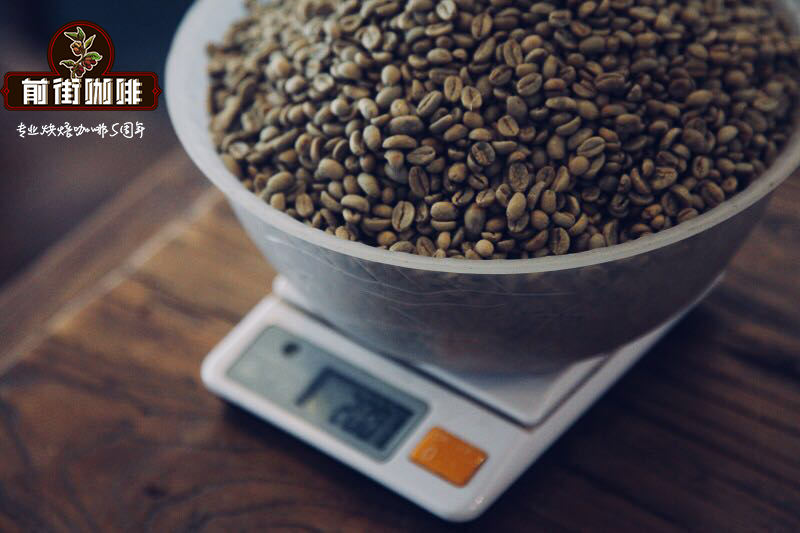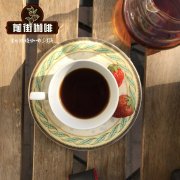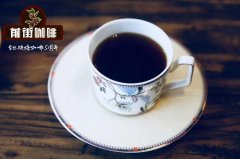Brazilian Black Coffee | Shirado producing area | Sami Boy Yellow bourbon PB adzuki beans

Professional coffee knowledge exchange more coffee bean information please follow the coffee workshop (Wechat official account cafe_style)
Qianjie Coffee Rose Summer 2018 | Panamanian Jade Manor Red Standard Solar | Blue Standard Water washing | Green Standard Solar
Country: Brazil
Producing area: Santo Ant ô nio do Amparo, south of South Minas.
The southern part of Minas, State of Minas Gerais
Name of the manor: Fazenda Samambaia nickname Sammy Boy
Owner: Dias Cambraia
Variety: Huang bourbon, Yellow Bourbon
Grading: adzuki bean (peaberry)
Treatment: hand extraction, followed by half-sun treatment (Pulp Natural)
Cup test report: baking time 12 minutes
Dry fragrance: sweet, almond stone, sour berry, oily fragrance
Wet fragrance: black sugar, caramel, nuts, fruit oily fragrance, creamy sweet fragrance
Sipping: the entrance is sweet, and after swallowing, body is quite thick and oily, and the flavor of spice and Japanese rice is still clear; the cheeks seem to be bright at first, but they turn soft in the middle of the entrance, and the flavors of almonds, nuts, peaches and plums are changeable; at low temperature, the cool fragrance is obvious, and the sweet aroma of almonds, milk and tea changes from time to time.
Fazenda Samambaia, after becoming famous, was listed as a fixed bean list of several well-known coffee boutiques, and was widely known after being repeatedly used as an espresso formula by celebrities, and was cited by barista in several countries and won these NB (Nathioal Body) winners many times. It is reported that in the national competition of WBC in 2007, it was chosen by many stores. Fazenda Samambaia is nicknamed Samy boy, that is, Sammy. The boy, Living Coffee of the travel adventure channel (host Paul Bassett is the 2003 WBC world champion) mentioned yellow bourbon as espresso in the program. In addition, the bean list of George Howell, the elder of boutique coffee, also found that it was on the list. Since Osher promoted yellow bourbon last year, this camellia yellow bourbon was imported for the first time in March, which really caused a stir, and the just-concluded Tokyo WBC competition You can also find that yellow bourbon is almost an important option for Brazilian bean formula.
The manor-grade bourbon produced in Brazil is full of sweetness and ripe, with rich fruit and red wine flavor and long-lasting aftertaste. The single product is boiled in an American coffee pot or used as an espresso formula bean, which makes professional experts satisfied and listed as a necessary purchase list! Osher has tested more than 20 kinds of yellow bourbon since the end of last year, and this batch of small round beans is the third wave this year! Huang bourbon's beans are sweet and clean, and the use of half-sun (or half-washing) will make her sour slightly brighter but better with sweet knots, and some of them even have the aroma of fruit red wine and the aroma of cooking.
This mountain rice yellow bourbon (Fazenda Samambaia) is owned by the innovative Dias Cambraia coffee family. The superior micro-climate in South Minas, the high altitude of more than 1.200 meters, the suitable temperature with an average annual temperature of no more than 21 °C and a temperature difference of more than 10 degrees in the morning and evening all contribute to the production of fine products in the region.
Fazenda Samambaia also has an excellent geographical condition, that is, he is located in an excellent area under the climate regulation of the two major rivers, which is also known as the water source and belongs to the watershed of the two major basins, the Great River, which is called "the Great River" by locals. The microclimate formed by the two rivers, the San Francisco River "River San Francisco", which flows to the south and to the northeast, makes coffee often cloudy during the growth period, but in the dry winter period. However, the clouds have disappeared, which makes it possible to have better opportunities for more sunlight to promote the sweetness and ripening of cherry fruits, and sun drying is also needed. Therefore, the climate here is not only very suitable for growing excellent coffee, but also has excellent conditions for post-harvest treatment of "post-harvest process". As a result, three or even four treatments have been developed in the region: sun drying, half-sun drying, water washing and half-washing. This is really rare in other countries!
Excellent geography and climate, coupled with the humanistic spirit of hard work and unity, have brewed a growing coffee culture. According to Henrique Dias Cambraia, the general manager of the manor, even when he went to the United States for further study for nearly a year, the team of the manor continued to make progress, creating amazing quality and good environmental maintenance. He deeply felt that the success of the manor, in addition to superior geographical conditions, It also includes: continuous progress and solid technical ability, fixed all-staff quality control and education, and family and team members who work together, that is, the following three points:
(1) the Dias Cambraia family employs Dr. Figueiredo, a technical expert from IBC, as a consultant for more than 10 years. The purpose of this consultant is to upgrade and take root in technology, including planting, treatment, quality improvement and overall personnel education and training. The doctor himself is an agronomic expert who is proficient in coffee, Agronomist Josu é Pereira de Figueiredo, Ph.D. His own farm ranked in the top 10 of the second CoE! Dr. Figueiredo is also the technical coordinator of the Brazilian Coffee Institute (IBC) Brazilian Coffee Institute.
Actively participate in the South Minas Coffee Association Association of the Coffee Producers of Southern Minas Gerais (Sulminas-Caf é), Henrique Dias Cambraia unreservedly contributed his estate management experience and technology to the Coffee Association, so later he was elected president of the South Minas Coffee Association, he and the 20 coffee producers under this association occupy a very important position in the Brazilian boutique coffee industry!
For example, most large coffee farms in Brazil use machines to harvest, but his exquisite estate uses manual harvesting of ripe cherries, weaves fabric to pick cherries, and after planting, sieves are used to remove sundries manually. You often see that Brazil has decorative copper ornaments with a pattern of women sifting through coffee cherries.
The coffee fruits harvested on that day must be sent to the treatment plant for half-sun treatment (Pulped Natural) on the same day. The coffee fruits are picked by hand and packed with woven fabric to avoid the local taste and any improper fermentation flavor. When the harvested coffee fruits arrive at the processing plant, they are immediately [received and cleaned], washed, screened out unqualified or dried fruits (b ó ia beans), and screened for qualified beans. The peeling operation will continue (using the pulper machine).
After removing the pulp of the coffee fruit, there is still a part of the pulp sticky layer (mucilage) in the sheepskin shell. At this time, the coffee fruit with the sticky layer is placed on the terrace to dry in the sun, so that the moisture content decreases. At this stage, the coffee fruit will absorb its own starch content, but it will not have the disadvantage of full-day drying and can not control the flavor of the drying process, because these residual sticky starch ingredients (starches) will have a special sweet feeling. But it doesn't get out of control and become off-fruit taste or musty, and the advantage is that the fruit is sweeter! When the moisture content is controlled close to the set conditions, it is moved to a special wooden container and stored for 60 days to slowly and steadily dry and ripen!
Shanmi, due to her unique high altitude and climate that changes a lot in a day, forms her unique aroma, which is a big gap from other coffee gardens planted in Huangbourne. The answer announced during the cup test has made many experts break their glasses. Some people even think that it is the milder volcanic beans in Africa and Central America.
Qianjie coffee: Guangzhou bakery, the store is small but a variety of beans, you can find a variety of unknown beans, but also provide online store services. Https://shop104210103.taobao.com
Important Notice :
前街咖啡 FrontStreet Coffee has moved to new addredd:
FrontStreet Coffee Address: 315,Donghua East Road,GuangZhou
Tel:020 38364473
- Prev

Kenyan Fine Coffee | Sri Tambaya processing Plant | Kenya AA TOP
Professional coffee knowledge exchange more coffee bean information please visit the coffee workshop (Wechat cafe_style) Kenya Nyeri Tambaya Factory AA TOP Double Handpick 2014 Coffee Review 95 points 2015 Coffee Review 94 points (Peaberry) 2016 Coffee Review 94 points Kenya Karitambaya processing Plant AA TOP
- Next

COE Coffee Manor, Brazil | FAZENDA DO SERTAO | Brazilian half-sun coffee beans
Professional coffee knowledge exchange more coffee bean information please follow Coffee Workshop (official Wechat account cafe_style) Front Street Coffee Rose Summer 2018 | Panamanian Jade Manor Red Standard Sun | Blue Standard Water washing | Green label Sun Manor name: Fazenda Iracema Manor Age: from 1857 to the present Manor area: located in the south of Minas, Brazil name: Machado
Related
- Does Rose Summer choose Blue, Green or Red? Detailed explanation of Rose Summer Coffee plots and Classification in Panamanian Jade Manor
- What is the difference between the origin, producing area, processing plant, cooperative and manor of coffee beans?
- How fine does the espresso powder fit? how to grind the espresso?
- Sca coffee roasting degree color card coffee roasting degree 8 roasting color values what do you mean?
- The practice of lattes: how to make lattes at home
- Introduction to Indonesian Fine Coffee beans-- Java Coffee producing area of Indonesian Arabica Coffee
- How much will the flavor of light and medium roasted rose summer be expressed? What baking level is rose summer suitable for?
- Introduction to the characteristics of washing, sun-drying or wet-planing coffee commonly used in Mantenin, Indonesia
- Price characteristics of Arabica Coffee Bean Starbucks introduction to Manning Coffee Bean Taste producing area Variety Manor
- What is the authentic Yega flavor? What are the flavor characteristics of the really excellent Yejasuffi coffee beans?

